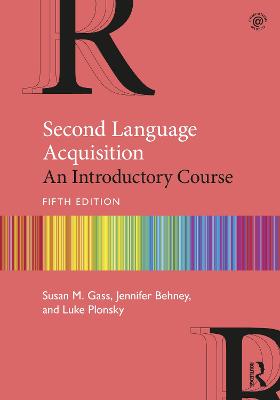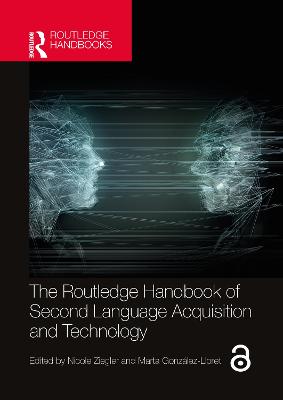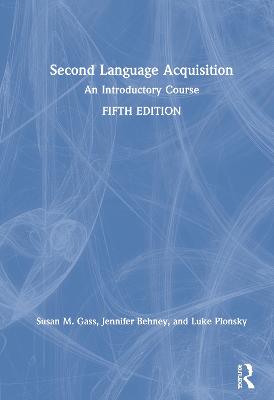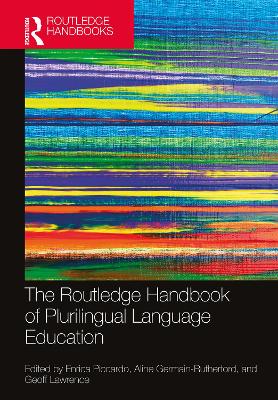Second Language Acquisition
 -10%
portes grátis
-10%
portes grátis
Second Language Acquisition
An Introductory Course
Plonsky, Luke; Behney, Jennifer; Gass, Susan M.
Taylor & Francis Ltd
06/2020
750
Mole
Inglês
9781138743427
15 a 20 dias
1430
Descrição não disponível.
Part One: Preliminaries
Chapter One: Introduction
1.1 THE STUDY OF SECOND LANGUAGE ACQUISITION
1.2 DEFINITIONS
1.3 THE NATURE OF LANGUAGE
1.3.1 Semantics
1.3.2 Pragmatics
1.3.3 Syntax
1.3.4 Morphology and the Lexicon
1.3.5 Sound Systems
1.4 THE NATURE OF NONNATIVE SPEAKER KNOWLEDGE
1.5 CONCLUSION
Chapter Two: Where Do Data Come From?
2.1 DATA TYPES
2.2 LEARNER CORPORA
2.3 DATA ELICITATION
2.3.1 Measuring General Proficiency
2.3.2 Measuring Nonlinguistic Information
2.3.3 Verbal Report Data
2.3.3.1 Think-Alouds
2.3.3.2 Stimulated Recall
2.3.3.3 Post-Production Interviews
2.3.4 Narrative Inquiry
2.3.5 Language-Elicitation Measures
2.3.5.1 Elicited Imitation
2.3.5.2 Judgments
2.3.5.3 Language Games
2.3.5.4 Discourse Completion
2.3.6 PROCESSING DATA
2.3.6.1 Reaction Time
2.3.6.2 Self-paced Reading
2.3.6.3 Eye-Tracking
2.3.6.4 Neurolinguistic Data
2.4 REPLICATION
2.5 META-ANALYSES
2.6 ISSUES IN DATA ANALYSIS
2.7 WHAT IS ACQUISITION?
2.8 CONCLUSION
Part Two: Historical Underpinnings of SLA Research
Chapter Three: The Role of the Native Language - A Historical Overview
3.1 INTRODUCTION
3.2 BEHAVIORISM
3.2.1 Linguistic Background
3.2.2 Psychological Background
3.3 CONTRASTIVE ANALYSIS HYPOTHESIS
3.4 ERROR ANALYSIS
3.5 CONCLUSION
Chapter Four: The Transition Period
4.1 INTRODUCTION
4.2 FIRST LANGUAGE ACQUISITION
4.2.1 Words
4.2.2 Sounds and Pronunciation
4.2.3 Syntax
4.2.4 Morphology
4.3 CHILD L2 ACQUISITION
4.4 CHILD L2 MORPHEME ORDER STUDIES
4.5 ADULT L2 MORPHEME ORDER STUDIES
4.6 THE MONITOR MODEL
4.6.1 The Acquisition-Learning Hypothesis
4.6.2 The Natural Order Hypothesis
4.6.3 The Monitor Hypothesis
4.6.4 The Input Hypothesis
4.6.5 The Affective Filter Hypothesis
4.6.6 Limitations
4.7 CONCLUSION
Chapter Five: Alternative Approaches to the Role of Previously Known Languages
5.1 REVISED PERSPECTIVES ON THE ROLE OF THE NATIVE LANGUAGE
5.1.1 Avoidance
5.1.2 Differential Learning Rates
5.1.3 Different Paths
5.1.4 Overproduction
5.1.5 Predictability/Selectivity
5.1.6 L1 Influences in L2 Processing
5.1.7 Morpheme Order
5.2 CONCLUSION
Part Three: A Focus on Form - Language Universals
Chapter Six: Formal Approaches to SLA
6.1 INTRODUCTION
6.2 UNIVERSAL GRAMMAR
6.2.1 Initial State
6.2.1.1 Fundamental Difference Hypothesis
6.2.1.2 Access to UG Hypothesis
6.2.2 UG Principles
6.2.3 UG Parameters
6.2.4 Minimalist Program
6.2.5 Falsification
6.3 TRANSFER: THE GENERATIVE/UG PERSPECTIVE
6.3.1 Levels of Representation
6.3.2 Clustering
6.3.3 Learnability
6.4 THE FUNDAMENTAL DIFFERENCE HYPOTHESIS REVISED
6.5 SEMANTICS AND THE SYNTAX-SEMANTICS INTERFACE HYPOTHESIS
6.5.1 Semantics
6.5.2 Syntax and Semantics: The Interface Hypothesis
6.6 PHONOLOGY
6.6.1 Markedness Differential Hypothesis
6.6.2 Similarity/Dissimilarity: Speech Learning Model
6.6.3 Optimality Theory
6.6.4 Ontogeny Phylogeny Model
6.7 CONCLUSION
Chapter Seven: Typological Approaches
7.1 TYPOLOGICAL UNIVERSALS
7.1.1 Test Case I: The Accessibility Hierarchy
7.1.2 Test Case II: The Acquisition of Questions
7.1.3 Test Case III: Voiced/Voiceless Consonants
7.2 FALSIFIABILITY
7.3 TYPOLOGICAL UNIVERSALS: CONCLUSION
7.4 TYPOLOGICAL PRIMACY MODEL
7.5 THE ROLE OF THE L1: THREE APPROACHES
7.6 CONCLUSION: GENERAL COMMENTS ABOUT UNIVERSALS
Part Four: A Focus on Meaning
Chapter Eight: Meaning-based Approaches
8.1 INTRODUCTION
8.2 FUNCTIONAL APPROACHES
8.2.1 The Relationship between Form and Function: Form-to-Function
8.2.2 Concept-oriented Approach
8.3 TENSE AND ASPECT: THE ASPECT HYPOTHESIS
8.4 THE DISCOURSE HYPOTHESIS
8.5 CONCLUSION
Chapter Nine: The Lexicon
9.1 THE SIGNIFICANCE OF THE LEXICON
9.2 LEXICAL KNOWLEDGE: WHAT DOES IT MEAN TO KNOW A WORD?
9.2.1 Production and Reception
9.2.2 Knowledge and Control
9.2.3 Breadth and Depth
9.2.4 Subcategorization
9.2.5 Word Associations and Networks
9.2.6 Word Formation
9.2.7 Formulaic Language, Collocations, and Chunking
9.2.7.1 Use of Multiword Units
9.2.7.2 Learning of Multiword Units
9.2.7.3 Processing of Multiword Units
9.3 INFLUENCES ON L2 VOCABULARY AND DEVELOPMENT
9.3.1 The Role of the L1
9.3.2 Incidental Vocabulary Learning
9.3.2.1 Input Type
9.3.2.2 What Helps Learning?
9.3.3 Depth of Processing
9.3.4 Incremental Vocabulary Learning
9.4 USING LEXICAL SKILLS
9.4.1 Production
9.4.2 Perception
9.5 CONCLUSION
Part Five: Cognitive and Processing Approaches to SLA
Chapter Ten: Psycholinguistic Approaches to Learning
10.1 INTRODUCTION
10.2 MODELS OF LANGUAGE PRODUCTION
10.3 PROCESSABILITY THEORY
10.4 PROCESSING OF INPUT
10.4.1 Input Processing
10.4.2 Processing Determinism
10.4.3 Autonomous Induction Theory
10.4.4 Shallow Structure Hypothesis
10.5 EMERGENTIST MODELS
10.5.1 Competition Model
10.5.2 Frequency-based Accounts
10.6 COMPLEX DYNAMIC SYSTEMS
10.7 SKILL ACQUISITION THEORY
10.8 CONCLUSION
Chapter Eleven: Psycholinguistic Constructs and Knowledge Types
11.1 INTRODUCTION
11.2 INFORMATION PROCESSING
11.2.1 Automaticity
11.2.2 Restructuring
11.2.3 U-shaped Learning
11.2.4 Attention
11.2.5 Working Memory
11.2.6. Salience
11.2.7 Priming
11.3 KNOWLEDGE TYPES
11.3.1 Acquisition/Learning
11.3.2 Declarative/Procedural
11.3.3 Implicit/Explicit
11.3.4 Representation/Control
11.4 INTERFACE OF KNOWLEDGE TYPES
11.4.1 No Interface
11.4.2 Weak Interface
11.4.3 Strong Interface
11.5 CONCLUSION
Part Six: The Social Environment of Learning
Chapter Twelve: Interlanguage in Context
12.1 INTRODUCTION
12.2 SOCIOCULTURAL APPROACHES
12.2.1 Mediation
12.2.2 Internalization
12.2.3 Zone of Proximal Development
12.2.4 Private Speech
12.2.5 Learning in a Sociocultural Framework
12.2.6 Gesture and SLA
12.3 SOCIOLINGUISTIC VARIATION
12.4 SYSTEMATIC VARIATION
12.4.1 Linguistic Context
12.4.2 Social Context Relating to the Native Language
12.4.3 Social Context Relating to Interlocutor, Task Type, and Conversational Topic
12.4.4 Sociolinguistic Norms
12.5 CONVERSATION ANALYSIS
12.6 COMMUNICATION STRATEGIES
12.7 L2 PRAGMATICS
12.8 CONCLUSION: SLA AND OTHER DISCIPLINES
Chapter Thirteen: Input, Interaction, and Output
13.1 INTRODUCTION
13.2 INPUT
13.3 COMPREHENSION
13.4 INTERACTION
13.5 OUTPUT
13.5.1 Hypothesis Testing
13.5.2 Automaticity
13.5.3 Meaning-based to Grammar-Based Processing
13.6. Feedback
13.6.1 Negotiation
13.6.2 Corrective Feedback
13.6.2.1 Recasts
13.6.2.2 Elicitation
13.6.2.3 Metalinguistic Feedback
13.7 THE ROLE OF INPUT AND INTERACTION IN LANGUAGE LEARNING
13.7.1 The Functions of Input and Interaction
13.7.2 Effectiveness of Feedback
13.7.2.1 Attention
13.7.2.2 Contrast Theory
13.7.2.3 Metalinguistic Awareness
13.7.3 Who Benefits From Interaction: When and Why?
13.8 LIMITATIONS OF INPUT
13.9 CONCLUSION
Chapter Fourteen: Contexts of Language Learning - Classrooms, Study Abroad, and Technology
14.1 INTRODUCTION
14.2 CLASSROOM-BASED INSTRUCTION
14.2.1 Classroom Language
14.2.2 Teachability/Learnability
14.2.3 Focus on Form and Task-based Language Teaching
14.2.3.1 Timing
14.2.3.2 Forms to Focus On
14.2.3.3 Task Design
14.2.3.4 Input Manipulation and Input Enhancement
14.3 COMPLEXITY, ACCURACY, FLUENCY, AND PLANNING
14.4 PROCESSING INSTRUCTION
14.5 UNIQUENESS OF INSTRUCTION
14.6 EFFECTIVENESS OF INSTRUCTION
14.7 SLA AND CLASSROOM PRACTICES
14.8 ADDITIONAL CONTEXTS
14.8.1 Study Abroad
14.8.2 Technology-enhanced Language Learning
14.9 CONCLUSION
Part Seven: The Individual Language Learner
Chapter Fifteen: Learner-internal Influences
15.1 INTRODUCTION
15.2 THE INFLUENCE OF PSYCHOLOGY IN SLA
15.3 METHODOLOGICAL CONSIDERATIONS
15.4 AGE DIFFERENCES
15.5 APTITUDE
15.6 MOTIVATION
15.6.1 Motivation as a Function of Time and Success
15.6.2 Changes over Time
15.6.3 The L2 Motivational Self System
15.6.4 Influence of Success on Motivation and Demotivation
15.7 AFFECT
15.7.1 Anxiety
15.7.2 Other Emotional Variables
15.8 PERSONALITY
15.8.1 Extroversion and Introversion
15.8.2 Grit
15.9 LEARNING STRATEGIES
15.10 CONCLUSION
Chapter Sixteen: Related Disciplines - A Focus on the Multilingual and Multimodal Learner
16.1 INTRODUCTION
16.2 BILINGUAL ACQUISITION
16.3 THIRD LANGUAGE ACQUISITION/MULTILINGUALISM
16.4 HERITAGE LANGUAGE ACQUISITION
16.5 SLA BY THE DEAF/HARD OF HEARING
16.6 CONCLUSION
Part Eight: Conclusion
Chapter Seventeen: An Integrated View of Second Language Acquisition
17.1 AN INTEGRATION OF SUB-AREAS
17.1.1 Apperceived Input
17.1.2 Comprehended Input
17.1.3 Intake
17.1.4 Integration
17.1.5 Output
17.2 CONCLUSION
Chapter One: Introduction
1.1 THE STUDY OF SECOND LANGUAGE ACQUISITION
1.2 DEFINITIONS
1.3 THE NATURE OF LANGUAGE
1.3.1 Semantics
1.3.2 Pragmatics
1.3.3 Syntax
1.3.4 Morphology and the Lexicon
1.3.5 Sound Systems
1.4 THE NATURE OF NONNATIVE SPEAKER KNOWLEDGE
1.5 CONCLUSION
Chapter Two: Where Do Data Come From?
2.1 DATA TYPES
2.2 LEARNER CORPORA
2.3 DATA ELICITATION
2.3.1 Measuring General Proficiency
2.3.2 Measuring Nonlinguistic Information
2.3.3 Verbal Report Data
2.3.3.1 Think-Alouds
2.3.3.2 Stimulated Recall
2.3.3.3 Post-Production Interviews
2.3.4 Narrative Inquiry
2.3.5 Language-Elicitation Measures
2.3.5.1 Elicited Imitation
2.3.5.2 Judgments
2.3.5.3 Language Games
2.3.5.4 Discourse Completion
2.3.6 PROCESSING DATA
2.3.6.1 Reaction Time
2.3.6.2 Self-paced Reading
2.3.6.3 Eye-Tracking
2.3.6.4 Neurolinguistic Data
2.4 REPLICATION
2.5 META-ANALYSES
2.6 ISSUES IN DATA ANALYSIS
2.7 WHAT IS ACQUISITION?
2.8 CONCLUSION
Part Two: Historical Underpinnings of SLA Research
Chapter Three: The Role of the Native Language - A Historical Overview
3.1 INTRODUCTION
3.2 BEHAVIORISM
3.2.1 Linguistic Background
3.2.2 Psychological Background
3.3 CONTRASTIVE ANALYSIS HYPOTHESIS
3.4 ERROR ANALYSIS
3.5 CONCLUSION
Chapter Four: The Transition Period
4.1 INTRODUCTION
4.2 FIRST LANGUAGE ACQUISITION
4.2.1 Words
4.2.2 Sounds and Pronunciation
4.2.3 Syntax
4.2.4 Morphology
4.3 CHILD L2 ACQUISITION
4.4 CHILD L2 MORPHEME ORDER STUDIES
4.5 ADULT L2 MORPHEME ORDER STUDIES
4.6 THE MONITOR MODEL
4.6.1 The Acquisition-Learning Hypothesis
4.6.2 The Natural Order Hypothesis
4.6.3 The Monitor Hypothesis
4.6.4 The Input Hypothesis
4.6.5 The Affective Filter Hypothesis
4.6.6 Limitations
4.7 CONCLUSION
Chapter Five: Alternative Approaches to the Role of Previously Known Languages
5.1 REVISED PERSPECTIVES ON THE ROLE OF THE NATIVE LANGUAGE
5.1.1 Avoidance
5.1.2 Differential Learning Rates
5.1.3 Different Paths
5.1.4 Overproduction
5.1.5 Predictability/Selectivity
5.1.6 L1 Influences in L2 Processing
5.1.7 Morpheme Order
5.2 CONCLUSION
Part Three: A Focus on Form - Language Universals
Chapter Six: Formal Approaches to SLA
6.1 INTRODUCTION
6.2 UNIVERSAL GRAMMAR
6.2.1 Initial State
6.2.1.1 Fundamental Difference Hypothesis
6.2.1.2 Access to UG Hypothesis
6.2.2 UG Principles
6.2.3 UG Parameters
6.2.4 Minimalist Program
6.2.5 Falsification
6.3 TRANSFER: THE GENERATIVE/UG PERSPECTIVE
6.3.1 Levels of Representation
6.3.2 Clustering
6.3.3 Learnability
6.4 THE FUNDAMENTAL DIFFERENCE HYPOTHESIS REVISED
6.5 SEMANTICS AND THE SYNTAX-SEMANTICS INTERFACE HYPOTHESIS
6.5.1 Semantics
6.5.2 Syntax and Semantics: The Interface Hypothesis
6.6 PHONOLOGY
6.6.1 Markedness Differential Hypothesis
6.6.2 Similarity/Dissimilarity: Speech Learning Model
6.6.3 Optimality Theory
6.6.4 Ontogeny Phylogeny Model
6.7 CONCLUSION
Chapter Seven: Typological Approaches
7.1 TYPOLOGICAL UNIVERSALS
7.1.1 Test Case I: The Accessibility Hierarchy
7.1.2 Test Case II: The Acquisition of Questions
7.1.3 Test Case III: Voiced/Voiceless Consonants
7.2 FALSIFIABILITY
7.3 TYPOLOGICAL UNIVERSALS: CONCLUSION
7.4 TYPOLOGICAL PRIMACY MODEL
7.5 THE ROLE OF THE L1: THREE APPROACHES
7.6 CONCLUSION: GENERAL COMMENTS ABOUT UNIVERSALS
Part Four: A Focus on Meaning
Chapter Eight: Meaning-based Approaches
8.1 INTRODUCTION
8.2 FUNCTIONAL APPROACHES
8.2.1 The Relationship between Form and Function: Form-to-Function
8.2.2 Concept-oriented Approach
8.3 TENSE AND ASPECT: THE ASPECT HYPOTHESIS
8.4 THE DISCOURSE HYPOTHESIS
8.5 CONCLUSION
Chapter Nine: The Lexicon
9.1 THE SIGNIFICANCE OF THE LEXICON
9.2 LEXICAL KNOWLEDGE: WHAT DOES IT MEAN TO KNOW A WORD?
9.2.1 Production and Reception
9.2.2 Knowledge and Control
9.2.3 Breadth and Depth
9.2.4 Subcategorization
9.2.5 Word Associations and Networks
9.2.6 Word Formation
9.2.7 Formulaic Language, Collocations, and Chunking
9.2.7.1 Use of Multiword Units
9.2.7.2 Learning of Multiword Units
9.2.7.3 Processing of Multiword Units
9.3 INFLUENCES ON L2 VOCABULARY AND DEVELOPMENT
9.3.1 The Role of the L1
9.3.2 Incidental Vocabulary Learning
9.3.2.1 Input Type
9.3.2.2 What Helps Learning?
9.3.3 Depth of Processing
9.3.4 Incremental Vocabulary Learning
9.4 USING LEXICAL SKILLS
9.4.1 Production
9.4.2 Perception
9.5 CONCLUSION
Part Five: Cognitive and Processing Approaches to SLA
Chapter Ten: Psycholinguistic Approaches to Learning
10.1 INTRODUCTION
10.2 MODELS OF LANGUAGE PRODUCTION
10.3 PROCESSABILITY THEORY
10.4 PROCESSING OF INPUT
10.4.1 Input Processing
10.4.2 Processing Determinism
10.4.3 Autonomous Induction Theory
10.4.4 Shallow Structure Hypothesis
10.5 EMERGENTIST MODELS
10.5.1 Competition Model
10.5.2 Frequency-based Accounts
10.6 COMPLEX DYNAMIC SYSTEMS
10.7 SKILL ACQUISITION THEORY
10.8 CONCLUSION
Chapter Eleven: Psycholinguistic Constructs and Knowledge Types
11.1 INTRODUCTION
11.2 INFORMATION PROCESSING
11.2.1 Automaticity
11.2.2 Restructuring
11.2.3 U-shaped Learning
11.2.4 Attention
11.2.5 Working Memory
11.2.6. Salience
11.2.7 Priming
11.3 KNOWLEDGE TYPES
11.3.1 Acquisition/Learning
11.3.2 Declarative/Procedural
11.3.3 Implicit/Explicit
11.3.4 Representation/Control
11.4 INTERFACE OF KNOWLEDGE TYPES
11.4.1 No Interface
11.4.2 Weak Interface
11.4.3 Strong Interface
11.5 CONCLUSION
Part Six: The Social Environment of Learning
Chapter Twelve: Interlanguage in Context
12.1 INTRODUCTION
12.2 SOCIOCULTURAL APPROACHES
12.2.1 Mediation
12.2.2 Internalization
12.2.3 Zone of Proximal Development
12.2.4 Private Speech
12.2.5 Learning in a Sociocultural Framework
12.2.6 Gesture and SLA
12.3 SOCIOLINGUISTIC VARIATION
12.4 SYSTEMATIC VARIATION
12.4.1 Linguistic Context
12.4.2 Social Context Relating to the Native Language
12.4.3 Social Context Relating to Interlocutor, Task Type, and Conversational Topic
12.4.4 Sociolinguistic Norms
12.5 CONVERSATION ANALYSIS
12.6 COMMUNICATION STRATEGIES
12.7 L2 PRAGMATICS
12.8 CONCLUSION: SLA AND OTHER DISCIPLINES
Chapter Thirteen: Input, Interaction, and Output
13.1 INTRODUCTION
13.2 INPUT
13.3 COMPREHENSION
13.4 INTERACTION
13.5 OUTPUT
13.5.1 Hypothesis Testing
13.5.2 Automaticity
13.5.3 Meaning-based to Grammar-Based Processing
13.6. Feedback
13.6.1 Negotiation
13.6.2 Corrective Feedback
13.6.2.1 Recasts
13.6.2.2 Elicitation
13.6.2.3 Metalinguistic Feedback
13.7 THE ROLE OF INPUT AND INTERACTION IN LANGUAGE LEARNING
13.7.1 The Functions of Input and Interaction
13.7.2 Effectiveness of Feedback
13.7.2.1 Attention
13.7.2.2 Contrast Theory
13.7.2.3 Metalinguistic Awareness
13.7.3 Who Benefits From Interaction: When and Why?
13.8 LIMITATIONS OF INPUT
13.9 CONCLUSION
Chapter Fourteen: Contexts of Language Learning - Classrooms, Study Abroad, and Technology
14.1 INTRODUCTION
14.2 CLASSROOM-BASED INSTRUCTION
14.2.1 Classroom Language
14.2.2 Teachability/Learnability
14.2.3 Focus on Form and Task-based Language Teaching
14.2.3.1 Timing
14.2.3.2 Forms to Focus On
14.2.3.3 Task Design
14.2.3.4 Input Manipulation and Input Enhancement
14.3 COMPLEXITY, ACCURACY, FLUENCY, AND PLANNING
14.4 PROCESSING INSTRUCTION
14.5 UNIQUENESS OF INSTRUCTION
14.6 EFFECTIVENESS OF INSTRUCTION
14.7 SLA AND CLASSROOM PRACTICES
14.8 ADDITIONAL CONTEXTS
14.8.1 Study Abroad
14.8.2 Technology-enhanced Language Learning
14.9 CONCLUSION
Part Seven: The Individual Language Learner
Chapter Fifteen: Learner-internal Influences
15.1 INTRODUCTION
15.2 THE INFLUENCE OF PSYCHOLOGY IN SLA
15.3 METHODOLOGICAL CONSIDERATIONS
15.4 AGE DIFFERENCES
15.5 APTITUDE
15.6 MOTIVATION
15.6.1 Motivation as a Function of Time and Success
15.6.2 Changes over Time
15.6.3 The L2 Motivational Self System
15.6.4 Influence of Success on Motivation and Demotivation
15.7 AFFECT
15.7.1 Anxiety
15.7.2 Other Emotional Variables
15.8 PERSONALITY
15.8.1 Extroversion and Introversion
15.8.2 Grit
15.9 LEARNING STRATEGIES
15.10 CONCLUSION
Chapter Sixteen: Related Disciplines - A Focus on the Multilingual and Multimodal Learner
16.1 INTRODUCTION
16.2 BILINGUAL ACQUISITION
16.3 THIRD LANGUAGE ACQUISITION/MULTILINGUALISM
16.4 HERITAGE LANGUAGE ACQUISITION
16.5 SLA BY THE DEAF/HARD OF HEARING
16.6 CONCLUSION
Part Eight: Conclusion
Chapter Seventeen: An Integrated View of Second Language Acquisition
17.1 AN INTEGRATION OF SUB-AREAS
17.1.1 Apperceived Input
17.1.2 Comprehended Input
17.1.3 Intake
17.1.4 Integration
17.1.5 Output
17.2 CONCLUSION
Este título pertence ao(s) assunto(s) indicados(s). Para ver outros títulos clique no assunto desejado.
L1 L2 Difference;Prior Vocabulary Knowledge;Second Language Acquisition;Heritage Language Learners;Susan Gass;Shallow Structure Hypothesis;Interaction;Involvement Load Hypothesis;Input;NNS.;Output;L2 Learner;Second Language;Competition Model;Foreign Language;Morpheme Order Studies;Data Analysis;RC Type;Native Language;L2 Grammar;Formal Approach;Syntactic Priming;Lexicon;Innate Language Faculty;Typological Approach;L3 Learners;Functional Approach;Working Memory;Psycholinguistic Approach;Cross-linguistic Influences;Instructed Second Language;Language Transfer;universal grammar;SLA Research;L2 Acquisition;processability theory;L1 Japanese Speaker;native language role;Vice Versa;Heritage Language;Np Referent;Resumptive Pronouns;Aspect Hypothesis
Part One: Preliminaries
Chapter One: Introduction
1.1 THE STUDY OF SECOND LANGUAGE ACQUISITION
1.2 DEFINITIONS
1.3 THE NATURE OF LANGUAGE
1.3.1 Semantics
1.3.2 Pragmatics
1.3.3 Syntax
1.3.4 Morphology and the Lexicon
1.3.5 Sound Systems
1.4 THE NATURE OF NONNATIVE SPEAKER KNOWLEDGE
1.5 CONCLUSION
Chapter Two: Where Do Data Come From?
2.1 DATA TYPES
2.2 LEARNER CORPORA
2.3 DATA ELICITATION
2.3.1 Measuring General Proficiency
2.3.2 Measuring Nonlinguistic Information
2.3.3 Verbal Report Data
2.3.3.1 Think-Alouds
2.3.3.2 Stimulated Recall
2.3.3.3 Post-Production Interviews
2.3.4 Narrative Inquiry
2.3.5 Language-Elicitation Measures
2.3.5.1 Elicited Imitation
2.3.5.2 Judgments
2.3.5.3 Language Games
2.3.5.4 Discourse Completion
2.3.6 PROCESSING DATA
2.3.6.1 Reaction Time
2.3.6.2 Self-paced Reading
2.3.6.3 Eye-Tracking
2.3.6.4 Neurolinguistic Data
2.4 REPLICATION
2.5 META-ANALYSES
2.6 ISSUES IN DATA ANALYSIS
2.7 WHAT IS ACQUISITION?
2.8 CONCLUSION
Part Two: Historical Underpinnings of SLA Research
Chapter Three: The Role of the Native Language - A Historical Overview
3.1 INTRODUCTION
3.2 BEHAVIORISM
3.2.1 Linguistic Background
3.2.2 Psychological Background
3.3 CONTRASTIVE ANALYSIS HYPOTHESIS
3.4 ERROR ANALYSIS
3.5 CONCLUSION
Chapter Four: The Transition Period
4.1 INTRODUCTION
4.2 FIRST LANGUAGE ACQUISITION
4.2.1 Words
4.2.2 Sounds and Pronunciation
4.2.3 Syntax
4.2.4 Morphology
4.3 CHILD L2 ACQUISITION
4.4 CHILD L2 MORPHEME ORDER STUDIES
4.5 ADULT L2 MORPHEME ORDER STUDIES
4.6 THE MONITOR MODEL
4.6.1 The Acquisition-Learning Hypothesis
4.6.2 The Natural Order Hypothesis
4.6.3 The Monitor Hypothesis
4.6.4 The Input Hypothesis
4.6.5 The Affective Filter Hypothesis
4.6.6 Limitations
4.7 CONCLUSION
Chapter Five: Alternative Approaches to the Role of Previously Known Languages
5.1 REVISED PERSPECTIVES ON THE ROLE OF THE NATIVE LANGUAGE
5.1.1 Avoidance
5.1.2 Differential Learning Rates
5.1.3 Different Paths
5.1.4 Overproduction
5.1.5 Predictability/Selectivity
5.1.6 L1 Influences in L2 Processing
5.1.7 Morpheme Order
5.2 CONCLUSION
Part Three: A Focus on Form - Language Universals
Chapter Six: Formal Approaches to SLA
6.1 INTRODUCTION
6.2 UNIVERSAL GRAMMAR
6.2.1 Initial State
6.2.1.1 Fundamental Difference Hypothesis
6.2.1.2 Access to UG Hypothesis
6.2.2 UG Principles
6.2.3 UG Parameters
6.2.4 Minimalist Program
6.2.5 Falsification
6.3 TRANSFER: THE GENERATIVE/UG PERSPECTIVE
6.3.1 Levels of Representation
6.3.2 Clustering
6.3.3 Learnability
6.4 THE FUNDAMENTAL DIFFERENCE HYPOTHESIS REVISED
6.5 SEMANTICS AND THE SYNTAX-SEMANTICS INTERFACE HYPOTHESIS
6.5.1 Semantics
6.5.2 Syntax and Semantics: The Interface Hypothesis
6.6 PHONOLOGY
6.6.1 Markedness Differential Hypothesis
6.6.2 Similarity/Dissimilarity: Speech Learning Model
6.6.3 Optimality Theory
6.6.4 Ontogeny Phylogeny Model
6.7 CONCLUSION
Chapter Seven: Typological Approaches
7.1 TYPOLOGICAL UNIVERSALS
7.1.1 Test Case I: The Accessibility Hierarchy
7.1.2 Test Case II: The Acquisition of Questions
7.1.3 Test Case III: Voiced/Voiceless Consonants
7.2 FALSIFIABILITY
7.3 TYPOLOGICAL UNIVERSALS: CONCLUSION
7.4 TYPOLOGICAL PRIMACY MODEL
7.5 THE ROLE OF THE L1: THREE APPROACHES
7.6 CONCLUSION: GENERAL COMMENTS ABOUT UNIVERSALS
Part Four: A Focus on Meaning
Chapter Eight: Meaning-based Approaches
8.1 INTRODUCTION
8.2 FUNCTIONAL APPROACHES
8.2.1 The Relationship between Form and Function: Form-to-Function
8.2.2 Concept-oriented Approach
8.3 TENSE AND ASPECT: THE ASPECT HYPOTHESIS
8.4 THE DISCOURSE HYPOTHESIS
8.5 CONCLUSION
Chapter Nine: The Lexicon
9.1 THE SIGNIFICANCE OF THE LEXICON
9.2 LEXICAL KNOWLEDGE: WHAT DOES IT MEAN TO KNOW A WORD?
9.2.1 Production and Reception
9.2.2 Knowledge and Control
9.2.3 Breadth and Depth
9.2.4 Subcategorization
9.2.5 Word Associations and Networks
9.2.6 Word Formation
9.2.7 Formulaic Language, Collocations, and Chunking
9.2.7.1 Use of Multiword Units
9.2.7.2 Learning of Multiword Units
9.2.7.3 Processing of Multiword Units
9.3 INFLUENCES ON L2 VOCABULARY AND DEVELOPMENT
9.3.1 The Role of the L1
9.3.2 Incidental Vocabulary Learning
9.3.2.1 Input Type
9.3.2.2 What Helps Learning?
9.3.3 Depth of Processing
9.3.4 Incremental Vocabulary Learning
9.4 USING LEXICAL SKILLS
9.4.1 Production
9.4.2 Perception
9.5 CONCLUSION
Part Five: Cognitive and Processing Approaches to SLA
Chapter Ten: Psycholinguistic Approaches to Learning
10.1 INTRODUCTION
10.2 MODELS OF LANGUAGE PRODUCTION
10.3 PROCESSABILITY THEORY
10.4 PROCESSING OF INPUT
10.4.1 Input Processing
10.4.2 Processing Determinism
10.4.3 Autonomous Induction Theory
10.4.4 Shallow Structure Hypothesis
10.5 EMERGENTIST MODELS
10.5.1 Competition Model
10.5.2 Frequency-based Accounts
10.6 COMPLEX DYNAMIC SYSTEMS
10.7 SKILL ACQUISITION THEORY
10.8 CONCLUSION
Chapter Eleven: Psycholinguistic Constructs and Knowledge Types
11.1 INTRODUCTION
11.2 INFORMATION PROCESSING
11.2.1 Automaticity
11.2.2 Restructuring
11.2.3 U-shaped Learning
11.2.4 Attention
11.2.5 Working Memory
11.2.6. Salience
11.2.7 Priming
11.3 KNOWLEDGE TYPES
11.3.1 Acquisition/Learning
11.3.2 Declarative/Procedural
11.3.3 Implicit/Explicit
11.3.4 Representation/Control
11.4 INTERFACE OF KNOWLEDGE TYPES
11.4.1 No Interface
11.4.2 Weak Interface
11.4.3 Strong Interface
11.5 CONCLUSION
Part Six: The Social Environment of Learning
Chapter Twelve: Interlanguage in Context
12.1 INTRODUCTION
12.2 SOCIOCULTURAL APPROACHES
12.2.1 Mediation
12.2.2 Internalization
12.2.3 Zone of Proximal Development
12.2.4 Private Speech
12.2.5 Learning in a Sociocultural Framework
12.2.6 Gesture and SLA
12.3 SOCIOLINGUISTIC VARIATION
12.4 SYSTEMATIC VARIATION
12.4.1 Linguistic Context
12.4.2 Social Context Relating to the Native Language
12.4.3 Social Context Relating to Interlocutor, Task Type, and Conversational Topic
12.4.4 Sociolinguistic Norms
12.5 CONVERSATION ANALYSIS
12.6 COMMUNICATION STRATEGIES
12.7 L2 PRAGMATICS
12.8 CONCLUSION: SLA AND OTHER DISCIPLINES
Chapter Thirteen: Input, Interaction, and Output
13.1 INTRODUCTION
13.2 INPUT
13.3 COMPREHENSION
13.4 INTERACTION
13.5 OUTPUT
13.5.1 Hypothesis Testing
13.5.2 Automaticity
13.5.3 Meaning-based to Grammar-Based Processing
13.6. Feedback
13.6.1 Negotiation
13.6.2 Corrective Feedback
13.6.2.1 Recasts
13.6.2.2 Elicitation
13.6.2.3 Metalinguistic Feedback
13.7 THE ROLE OF INPUT AND INTERACTION IN LANGUAGE LEARNING
13.7.1 The Functions of Input and Interaction
13.7.2 Effectiveness of Feedback
13.7.2.1 Attention
13.7.2.2 Contrast Theory
13.7.2.3 Metalinguistic Awareness
13.7.3 Who Benefits From Interaction: When and Why?
13.8 LIMITATIONS OF INPUT
13.9 CONCLUSION
Chapter Fourteen: Contexts of Language Learning - Classrooms, Study Abroad, and Technology
14.1 INTRODUCTION
14.2 CLASSROOM-BASED INSTRUCTION
14.2.1 Classroom Language
14.2.2 Teachability/Learnability
14.2.3 Focus on Form and Task-based Language Teaching
14.2.3.1 Timing
14.2.3.2 Forms to Focus On
14.2.3.3 Task Design
14.2.3.4 Input Manipulation and Input Enhancement
14.3 COMPLEXITY, ACCURACY, FLUENCY, AND PLANNING
14.4 PROCESSING INSTRUCTION
14.5 UNIQUENESS OF INSTRUCTION
14.6 EFFECTIVENESS OF INSTRUCTION
14.7 SLA AND CLASSROOM PRACTICES
14.8 ADDITIONAL CONTEXTS
14.8.1 Study Abroad
14.8.2 Technology-enhanced Language Learning
14.9 CONCLUSION
Part Seven: The Individual Language Learner
Chapter Fifteen: Learner-internal Influences
15.1 INTRODUCTION
15.2 THE INFLUENCE OF PSYCHOLOGY IN SLA
15.3 METHODOLOGICAL CONSIDERATIONS
15.4 AGE DIFFERENCES
15.5 APTITUDE
15.6 MOTIVATION
15.6.1 Motivation as a Function of Time and Success
15.6.2 Changes over Time
15.6.3 The L2 Motivational Self System
15.6.4 Influence of Success on Motivation and Demotivation
15.7 AFFECT
15.7.1 Anxiety
15.7.2 Other Emotional Variables
15.8 PERSONALITY
15.8.1 Extroversion and Introversion
15.8.2 Grit
15.9 LEARNING STRATEGIES
15.10 CONCLUSION
Chapter Sixteen: Related Disciplines - A Focus on the Multilingual and Multimodal Learner
16.1 INTRODUCTION
16.2 BILINGUAL ACQUISITION
16.3 THIRD LANGUAGE ACQUISITION/MULTILINGUALISM
16.4 HERITAGE LANGUAGE ACQUISITION
16.5 SLA BY THE DEAF/HARD OF HEARING
16.6 CONCLUSION
Part Eight: Conclusion
Chapter Seventeen: An Integrated View of Second Language Acquisition
17.1 AN INTEGRATION OF SUB-AREAS
17.1.1 Apperceived Input
17.1.2 Comprehended Input
17.1.3 Intake
17.1.4 Integration
17.1.5 Output
17.2 CONCLUSION
Chapter One: Introduction
1.1 THE STUDY OF SECOND LANGUAGE ACQUISITION
1.2 DEFINITIONS
1.3 THE NATURE OF LANGUAGE
1.3.1 Semantics
1.3.2 Pragmatics
1.3.3 Syntax
1.3.4 Morphology and the Lexicon
1.3.5 Sound Systems
1.4 THE NATURE OF NONNATIVE SPEAKER KNOWLEDGE
1.5 CONCLUSION
Chapter Two: Where Do Data Come From?
2.1 DATA TYPES
2.2 LEARNER CORPORA
2.3 DATA ELICITATION
2.3.1 Measuring General Proficiency
2.3.2 Measuring Nonlinguistic Information
2.3.3 Verbal Report Data
2.3.3.1 Think-Alouds
2.3.3.2 Stimulated Recall
2.3.3.3 Post-Production Interviews
2.3.4 Narrative Inquiry
2.3.5 Language-Elicitation Measures
2.3.5.1 Elicited Imitation
2.3.5.2 Judgments
2.3.5.3 Language Games
2.3.5.4 Discourse Completion
2.3.6 PROCESSING DATA
2.3.6.1 Reaction Time
2.3.6.2 Self-paced Reading
2.3.6.3 Eye-Tracking
2.3.6.4 Neurolinguistic Data
2.4 REPLICATION
2.5 META-ANALYSES
2.6 ISSUES IN DATA ANALYSIS
2.7 WHAT IS ACQUISITION?
2.8 CONCLUSION
Part Two: Historical Underpinnings of SLA Research
Chapter Three: The Role of the Native Language - A Historical Overview
3.1 INTRODUCTION
3.2 BEHAVIORISM
3.2.1 Linguistic Background
3.2.2 Psychological Background
3.3 CONTRASTIVE ANALYSIS HYPOTHESIS
3.4 ERROR ANALYSIS
3.5 CONCLUSION
Chapter Four: The Transition Period
4.1 INTRODUCTION
4.2 FIRST LANGUAGE ACQUISITION
4.2.1 Words
4.2.2 Sounds and Pronunciation
4.2.3 Syntax
4.2.4 Morphology
4.3 CHILD L2 ACQUISITION
4.4 CHILD L2 MORPHEME ORDER STUDIES
4.5 ADULT L2 MORPHEME ORDER STUDIES
4.6 THE MONITOR MODEL
4.6.1 The Acquisition-Learning Hypothesis
4.6.2 The Natural Order Hypothesis
4.6.3 The Monitor Hypothesis
4.6.4 The Input Hypothesis
4.6.5 The Affective Filter Hypothesis
4.6.6 Limitations
4.7 CONCLUSION
Chapter Five: Alternative Approaches to the Role of Previously Known Languages
5.1 REVISED PERSPECTIVES ON THE ROLE OF THE NATIVE LANGUAGE
5.1.1 Avoidance
5.1.2 Differential Learning Rates
5.1.3 Different Paths
5.1.4 Overproduction
5.1.5 Predictability/Selectivity
5.1.6 L1 Influences in L2 Processing
5.1.7 Morpheme Order
5.2 CONCLUSION
Part Three: A Focus on Form - Language Universals
Chapter Six: Formal Approaches to SLA
6.1 INTRODUCTION
6.2 UNIVERSAL GRAMMAR
6.2.1 Initial State
6.2.1.1 Fundamental Difference Hypothesis
6.2.1.2 Access to UG Hypothesis
6.2.2 UG Principles
6.2.3 UG Parameters
6.2.4 Minimalist Program
6.2.5 Falsification
6.3 TRANSFER: THE GENERATIVE/UG PERSPECTIVE
6.3.1 Levels of Representation
6.3.2 Clustering
6.3.3 Learnability
6.4 THE FUNDAMENTAL DIFFERENCE HYPOTHESIS REVISED
6.5 SEMANTICS AND THE SYNTAX-SEMANTICS INTERFACE HYPOTHESIS
6.5.1 Semantics
6.5.2 Syntax and Semantics: The Interface Hypothesis
6.6 PHONOLOGY
6.6.1 Markedness Differential Hypothesis
6.6.2 Similarity/Dissimilarity: Speech Learning Model
6.6.3 Optimality Theory
6.6.4 Ontogeny Phylogeny Model
6.7 CONCLUSION
Chapter Seven: Typological Approaches
7.1 TYPOLOGICAL UNIVERSALS
7.1.1 Test Case I: The Accessibility Hierarchy
7.1.2 Test Case II: The Acquisition of Questions
7.1.3 Test Case III: Voiced/Voiceless Consonants
7.2 FALSIFIABILITY
7.3 TYPOLOGICAL UNIVERSALS: CONCLUSION
7.4 TYPOLOGICAL PRIMACY MODEL
7.5 THE ROLE OF THE L1: THREE APPROACHES
7.6 CONCLUSION: GENERAL COMMENTS ABOUT UNIVERSALS
Part Four: A Focus on Meaning
Chapter Eight: Meaning-based Approaches
8.1 INTRODUCTION
8.2 FUNCTIONAL APPROACHES
8.2.1 The Relationship between Form and Function: Form-to-Function
8.2.2 Concept-oriented Approach
8.3 TENSE AND ASPECT: THE ASPECT HYPOTHESIS
8.4 THE DISCOURSE HYPOTHESIS
8.5 CONCLUSION
Chapter Nine: The Lexicon
9.1 THE SIGNIFICANCE OF THE LEXICON
9.2 LEXICAL KNOWLEDGE: WHAT DOES IT MEAN TO KNOW A WORD?
9.2.1 Production and Reception
9.2.2 Knowledge and Control
9.2.3 Breadth and Depth
9.2.4 Subcategorization
9.2.5 Word Associations and Networks
9.2.6 Word Formation
9.2.7 Formulaic Language, Collocations, and Chunking
9.2.7.1 Use of Multiword Units
9.2.7.2 Learning of Multiword Units
9.2.7.3 Processing of Multiword Units
9.3 INFLUENCES ON L2 VOCABULARY AND DEVELOPMENT
9.3.1 The Role of the L1
9.3.2 Incidental Vocabulary Learning
9.3.2.1 Input Type
9.3.2.2 What Helps Learning?
9.3.3 Depth of Processing
9.3.4 Incremental Vocabulary Learning
9.4 USING LEXICAL SKILLS
9.4.1 Production
9.4.2 Perception
9.5 CONCLUSION
Part Five: Cognitive and Processing Approaches to SLA
Chapter Ten: Psycholinguistic Approaches to Learning
10.1 INTRODUCTION
10.2 MODELS OF LANGUAGE PRODUCTION
10.3 PROCESSABILITY THEORY
10.4 PROCESSING OF INPUT
10.4.1 Input Processing
10.4.2 Processing Determinism
10.4.3 Autonomous Induction Theory
10.4.4 Shallow Structure Hypothesis
10.5 EMERGENTIST MODELS
10.5.1 Competition Model
10.5.2 Frequency-based Accounts
10.6 COMPLEX DYNAMIC SYSTEMS
10.7 SKILL ACQUISITION THEORY
10.8 CONCLUSION
Chapter Eleven: Psycholinguistic Constructs and Knowledge Types
11.1 INTRODUCTION
11.2 INFORMATION PROCESSING
11.2.1 Automaticity
11.2.2 Restructuring
11.2.3 U-shaped Learning
11.2.4 Attention
11.2.5 Working Memory
11.2.6. Salience
11.2.7 Priming
11.3 KNOWLEDGE TYPES
11.3.1 Acquisition/Learning
11.3.2 Declarative/Procedural
11.3.3 Implicit/Explicit
11.3.4 Representation/Control
11.4 INTERFACE OF KNOWLEDGE TYPES
11.4.1 No Interface
11.4.2 Weak Interface
11.4.3 Strong Interface
11.5 CONCLUSION
Part Six: The Social Environment of Learning
Chapter Twelve: Interlanguage in Context
12.1 INTRODUCTION
12.2 SOCIOCULTURAL APPROACHES
12.2.1 Mediation
12.2.2 Internalization
12.2.3 Zone of Proximal Development
12.2.4 Private Speech
12.2.5 Learning in a Sociocultural Framework
12.2.6 Gesture and SLA
12.3 SOCIOLINGUISTIC VARIATION
12.4 SYSTEMATIC VARIATION
12.4.1 Linguistic Context
12.4.2 Social Context Relating to the Native Language
12.4.3 Social Context Relating to Interlocutor, Task Type, and Conversational Topic
12.4.4 Sociolinguistic Norms
12.5 CONVERSATION ANALYSIS
12.6 COMMUNICATION STRATEGIES
12.7 L2 PRAGMATICS
12.8 CONCLUSION: SLA AND OTHER DISCIPLINES
Chapter Thirteen: Input, Interaction, and Output
13.1 INTRODUCTION
13.2 INPUT
13.3 COMPREHENSION
13.4 INTERACTION
13.5 OUTPUT
13.5.1 Hypothesis Testing
13.5.2 Automaticity
13.5.3 Meaning-based to Grammar-Based Processing
13.6. Feedback
13.6.1 Negotiation
13.6.2 Corrective Feedback
13.6.2.1 Recasts
13.6.2.2 Elicitation
13.6.2.3 Metalinguistic Feedback
13.7 THE ROLE OF INPUT AND INTERACTION IN LANGUAGE LEARNING
13.7.1 The Functions of Input and Interaction
13.7.2 Effectiveness of Feedback
13.7.2.1 Attention
13.7.2.2 Contrast Theory
13.7.2.3 Metalinguistic Awareness
13.7.3 Who Benefits From Interaction: When and Why?
13.8 LIMITATIONS OF INPUT
13.9 CONCLUSION
Chapter Fourteen: Contexts of Language Learning - Classrooms, Study Abroad, and Technology
14.1 INTRODUCTION
14.2 CLASSROOM-BASED INSTRUCTION
14.2.1 Classroom Language
14.2.2 Teachability/Learnability
14.2.3 Focus on Form and Task-based Language Teaching
14.2.3.1 Timing
14.2.3.2 Forms to Focus On
14.2.3.3 Task Design
14.2.3.4 Input Manipulation and Input Enhancement
14.3 COMPLEXITY, ACCURACY, FLUENCY, AND PLANNING
14.4 PROCESSING INSTRUCTION
14.5 UNIQUENESS OF INSTRUCTION
14.6 EFFECTIVENESS OF INSTRUCTION
14.7 SLA AND CLASSROOM PRACTICES
14.8 ADDITIONAL CONTEXTS
14.8.1 Study Abroad
14.8.2 Technology-enhanced Language Learning
14.9 CONCLUSION
Part Seven: The Individual Language Learner
Chapter Fifteen: Learner-internal Influences
15.1 INTRODUCTION
15.2 THE INFLUENCE OF PSYCHOLOGY IN SLA
15.3 METHODOLOGICAL CONSIDERATIONS
15.4 AGE DIFFERENCES
15.5 APTITUDE
15.6 MOTIVATION
15.6.1 Motivation as a Function of Time and Success
15.6.2 Changes over Time
15.6.3 The L2 Motivational Self System
15.6.4 Influence of Success on Motivation and Demotivation
15.7 AFFECT
15.7.1 Anxiety
15.7.2 Other Emotional Variables
15.8 PERSONALITY
15.8.1 Extroversion and Introversion
15.8.2 Grit
15.9 LEARNING STRATEGIES
15.10 CONCLUSION
Chapter Sixteen: Related Disciplines - A Focus on the Multilingual and Multimodal Learner
16.1 INTRODUCTION
16.2 BILINGUAL ACQUISITION
16.3 THIRD LANGUAGE ACQUISITION/MULTILINGUALISM
16.4 HERITAGE LANGUAGE ACQUISITION
16.5 SLA BY THE DEAF/HARD OF HEARING
16.6 CONCLUSION
Part Eight: Conclusion
Chapter Seventeen: An Integrated View of Second Language Acquisition
17.1 AN INTEGRATION OF SUB-AREAS
17.1.1 Apperceived Input
17.1.2 Comprehended Input
17.1.3 Intake
17.1.4 Integration
17.1.5 Output
17.2 CONCLUSION
Este título pertence ao(s) assunto(s) indicados(s). Para ver outros títulos clique no assunto desejado.
L1 L2 Difference;Prior Vocabulary Knowledge;Second Language Acquisition;Heritage Language Learners;Susan Gass;Shallow Structure Hypothesis;Interaction;Involvement Load Hypothesis;Input;NNS.;Output;L2 Learner;Second Language;Competition Model;Foreign Language;Morpheme Order Studies;Data Analysis;RC Type;Native Language;L2 Grammar;Formal Approach;Syntactic Priming;Lexicon;Innate Language Faculty;Typological Approach;L3 Learners;Functional Approach;Working Memory;Psycholinguistic Approach;Cross-linguistic Influences;Instructed Second Language;Language Transfer;universal grammar;SLA Research;L2 Acquisition;processability theory;L1 Japanese Speaker;native language role;Vice Versa;Heritage Language;Np Referent;Resumptive Pronouns;Aspect Hypothesis







